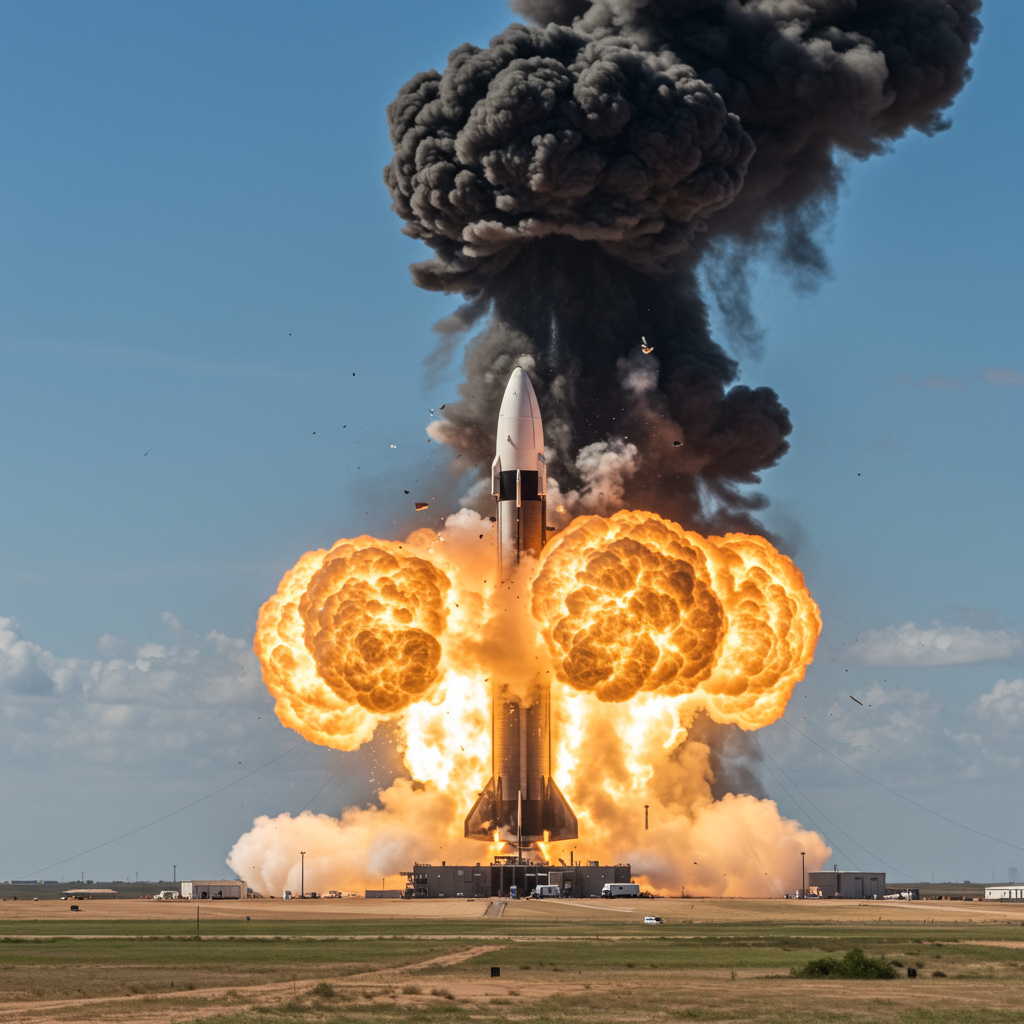SpaceX Starship Prototype Explodes During Static Fire Test in Texas
A SpaceX Starship prototype, identified as Starship 36, dramatically exploded during a routine static fire test at the company’s Starbase facility near Brownsville, Texas, late Wednesday, June 18, 2025. The incident, confirmed by local authorities as a “catastrophic failure” and by SpaceX as a “major anomaly,” occurred around 11 p.m. local time (0400 GMT Thursday) as the vehicle was preparing for its tenth test flight.
Video footage shared online captured the intense moment, showing the massive rocket attached to the launch tower before a sudden flash ignited a towering, fiery explosion that illuminated the night sky.
SpaceX confirmed that all personnel remained safe and accounted for, with a safety clear area maintained throughout the operation. Authorities also assured residents in surrounding communities that there were no hazards, requesting individuals stay away from the area during “safing” operations.
Potential Cause Emerges Amidst Investigation
While SpaceX stated they would investigate the “major anomaly,” company founder Elon Musk offered a preliminary assessment shortly after the event. According to Musk’s initial data, the explosion may have been caused by the failure of a nitrogen Composite Overwrapped Pressure Vessel (COPV) located in the Starship’s payload bay. He noted that this failure appeared to occur below the component’s expected proof pressure and, if confirmed by further investigation, would represent the first instance of this specific COPV design failing in this manner. Reports from the scene suggested at least two rapid explosions occurred.
Latest Challenge for Musk’s Mars Vision
This explosion during ground testing marks the latest in a series of setbacks for SpaceX’s ambitious Starship program in 2025. Starship is central to Elon Musk’s long-term vision of transforming humanity into an interplanetary species, with the ultimate goal of establishing a self-sustaining colony on Mars.
Standing 123 meters (403 feet) tall, Starship is the world’s largest and most powerful rocket system ever developed. It is designed to be fully reusable, capable of transporting enormous payloads of up to 150 metric tonnes to orbit and beyond, including eventually carrying humans to the Moon and Mars.
Recent test flight anomalies earlier in the year have highlighted the challenges of developing such a complex system:
Late May 2025: During its ninth test flight, a Starship prototype experienced a “rapid unscheduled disassembly,” spinning out of control about halfway through its planned mission and breaking apart over the Indian Ocean.
March 2025: A test flight ended with the spacecraft exploding in space minutes after launch from Texas. Live streams showed the vehicle spinning uncontrollably before disintegration, with debris reportedly seen near Florida and the Bahamas. The FAA later cited a hardware failure in one engine as the probable cause and required SpaceX to implement eight corrective actions.
- January 2025: An earlier Starship test also broke up in space shortly after liftoff, resulting in debris falling over Caribbean islands, including minor property damage in Turks and Caicos.
- www.theguardian.com
- www.usatoday.com
- www.unionleader.com
- www.livemint.com
- www.irishtimes.com
Despite these dramatic failures, SpaceX operates under a well-known “fail fast, learn fast” development philosophy, which the company credits for its rapid progress in other areas of commercial spaceflight.
Balancing Setbacks with Progress
While the recent explosion is undoubtedly a setback, SpaceX continues to make progress on key engineering challenges. The company has successfully demonstrated catching the massive Super Heavy booster – the first stage of the Starship system – with the Starbase launch tower’s giant robotic arms on multiple occasions. This capability is seen as crucial for achieving rapid reusability and drastically reducing launch costs.
Furthermore, SpaceX remains a vital partner for NASA, regularly ferrying astronauts to and from the International Space Station using its Dragon spacecraft. Regulatory approvals for Starship launches have also increased, with the Federal Aviation Administration (FAA) authorizing an increase from five to up to 25 launches annually in May, despite objections from environmental groups concerned about potential impacts on local wildlife.
The explosion during the static fire test underscores the inherent risks and complexities involved in developing cutting-edge space technology aimed at enabling deep space missions. While it impacts the immediate test flight schedule, the incident is part of an iterative development process that SpaceX believes will eventually pave the way for achieving Elon Musk’s ambitious goals for Mars and beyond.



